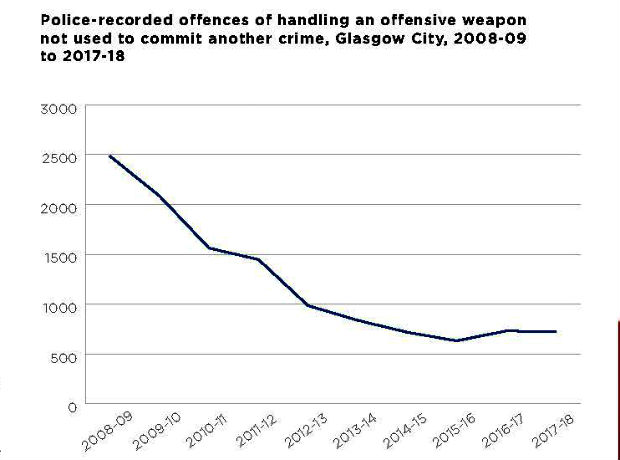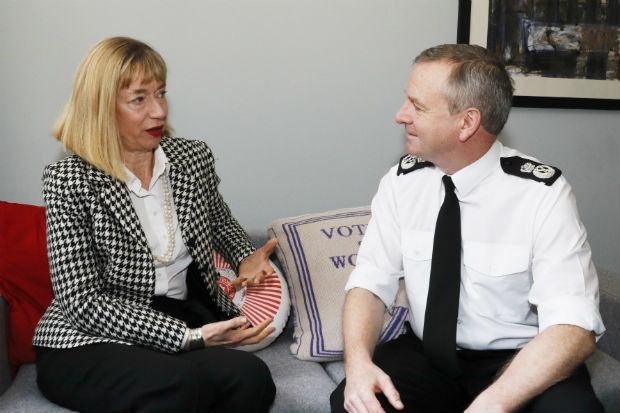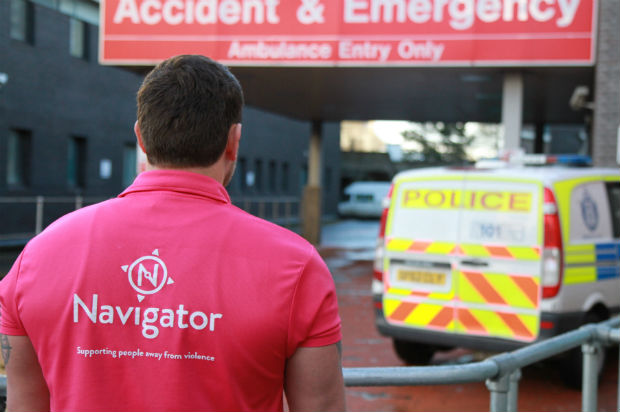
Over the last few months, EU Exit has dominated the news and has led to an unprecedented and intensive organisational response across all areas of government. But another issue has never been far from the headlines. Knife crime in England and Wales has continued to rise, with the loss of too many young lives.
The statistics are stark. Last year, there were 209 knife-related fatalities in England and Wales – the highest since records began in 1946. As I write, there have been over 20 fatalities from stabbings in London this year – real people and real families’ lives shattered.
Here in Scotland we have an important story to share, in how we have reframed this problem and implemented a radical approach to tackling knife crime. As a result, key decision makers – including the Commissioner of the Metropolitan Police and the Justice Minister for England and Wales – have been looking to Scotland to learn about our experience of dealing with knife crime.
The UK Government, the police and the authorities have refocused their efforts to tackle the problem. There has been political will from all sides and an impressive range of initiatives deployed. A violence reduction unit has been set up in London with
the promise of more to follow. Changes are being proposed to the laws governing offensive weapons. And community-based approaches have been introduced to provide positive alternatives for young people who are most at risk
of becoming involved in knife possession and knife crime.
The Scottish context
Each local context is unique, and Scotland has its own particular experience of these issues. Around 14 years ago, stabbings certainly seemed to be a ‘Scottish problem’, with Glasgow gaining a dubious reputation as the UK’s capital of knife crime. At that time, young men were routinely turning up at hospital emergency departments with horrific knife wounds. Gang-related violence had become a depressing - and seemingly inevitable - way of life for many. In 2005, both the UN and the World Health Organization published reports highlighting the issue and Scotland’s appalling record on violent crime.
In response, the authorities took the bold decision to form Scotland’s Violence Reduction Unit (SVRU). This was Scotland’s first independent centre of expertise on the issue, funded by central government since 2006.
A different approach
The SVRU offered something different. It was independent of the police and so did not treat violence as a traditional law and order matter. Rather, it viewed violence as a public health issue – as a “disease affecting communities”. And because that disease is caused by poverty, inequality and despair – issues that lie outside the bounds of policing – the SVRU knew that an alternative approach was required, one that dealt with the root causes of violence and tried to prevent it happening in the first place.
The SVRU searched the world for possible solutions to tackle Glasgow’s violence. This included approaches being developed in Chicago (which involved mapping the epidemic curves of violence, in the same way that this method is applied to containing infectious diseases); and Boston (where gang members were given the option to renounce violence and get into education or
work, or face tough penalties). In both of these American cities, traditional enforcement measures were being used alongside preventative measures, in line with the public health approach.
From the outset, the SVRU’s mantra was that violence is always preventable, not inevitable. By diagnosing violent behaviour much like any other disease, the SVRU analysed the causes, examined what works and developed solutions. Once evaluated, these solutions were scaled up to help other communities across the country.
Prevention and engagement
Iain Murray, who previously worked as a police inspector for the SVRU, neatly summed up this shift towards prevention in a media interview. From the start, he says, the SVRU attempted to “understand what the problems are”:
The police for years had been experts at detection and enforcement. I’d much rather be at the top of the cliff putting a fence up, stopping someone from jumping over, rather than at the bottom of the cliff waiting until they’ve jumped. That’s the public health approach as far as I’m concerned. You’re engineering out issues, rather than waiting for them to happen.
The SVRU was pioneering in another respect. It engaged directly with some of the most violent and disruptive young people in the country. It was – and still is – relentless in its approach. It drafted in former offenders - inspirational individuals - to share their experience. It encouraged team-building and fostered empathy. It showed that there were alternatives to lives impoverished by gangs, alcohol and toxic masculinity.
As a result, behaviours began to change. Threats were replaced with respect. Rivalry and territoriality were replaced by compassion and hope. And, very gradually, some long-established gangs began to disperse.
The impact in Scotland has been profound. All the key indicators point towards a sustained long-term reduction in levels
of violence. Most recently, the publication of Scotland’s Crime and Justice Survey showed that violent crime has reduced by nearly half in the last decade. Similarly, emergency hospital admissions for assault fell by 55% between 2008-09 and 2017-18. During the same period, the proportion of recorded serious assaults cleared up by the police has increased from 62% to 79%. Between 2006-07 and 2017-18 there has been a 65% decrease in crimes of handling offensive weapons
(not used in crimes against the person).

Range of measures
However, we know violence remains a very real problem in Scotland. The Scottish Government and authorities know we must continue to work hard to sustain the downward trend. Domestic abuse and sexual violence remain significant areas for concern
– as does the often toxic relationship between alcohol and violence, which still features in the majority of serious assaults in Scotland.
However, there has certainly been a shift in our focus in dealing with the problem. Stop-and-search as an early enforcement tactic had a role to play but, in Scotland, the emphasis has not been on tough enforcement; our police and authorities have long realised that we cannot simply arrest our way out of the problem. As such, stop-and-search must be used proportionately, alongside a range of other measures, such as prevention and education. Above all, the absolute focus is on policing by consent and community partnerships. This means that the police and authorities have actively sought to engage with young people at risk, built trust and forged better relationships with them.

Connecting with young people
The Scottish Government has an overarching policy aim to make Scotland the best place to grow up for all our children and young people. As Permanent Secretary to the Scottish Government, engagement with young people is, therefore, central to my role, permeating everything that I do. Over the last few years, I have been especially proud of the way that the Scottish Government has connected directly with young people, not only through the SVRU but also through a range of programmes to prevent them from falling into violent lifestyles. Programmes such as No Knives Better Lives, Police Scotland Youth Volunteers, and Mentors in Violence Prevention all offer young people opportunities to engage and for their voices to be heard.
In terms of youth justice, the Scottish Government is pioneering the Whole Systems Approach. This highlights the importance of different organisations and professions working together to support children and young people before situations reach crisis point. In Getting it Right for Every Child, we also have a national approach for improving outcomes and supporting the wellbeing of our children and young people by offering the right help, at the right time, from the right people.
Breaking the cycle
Since 2015, the Scottish Government has also supported a Navigator programme, now operational in four Scottish hospitals. The Navigators use the opportunity provided when people with chaotic lifestyles are admitted to hospital, to break the cycle and help them gain access to vital services. Many of these individuals are repeat victims of violence.
I saw the programme in action when I visited Edinburgh Royal Infirmary and heard vivid and unforgettable stories about how Navigators are empowering victims of violence and offering them a helping hand at those ‘reachable moments’. I was inspired by the commitment and compassion from both medical and non-medical staff. One consultant summed it up when she said it was “lovely, at last, to have hope for these patients when they leave hospital”. Kindness is a word that is not used often enough in the context of public services, but the work of Navigators certainly has kindness and compassion at its core.

National Performance Framework
And kindness features in Scotland’s recently refreshed National Performance Framework. The framework has been in place for over a decade, ensuring that all policies are sharply focused on the achievement of national outcomes, with opportunities for all of Scotland to flourish. As with all work on violence, the Navigator programme is aligned to the achievement of an overarching national outcome (in this case, that “we live in communities that are inclusive, empowered, resilient and safe”). In this way, we describe the difference the approach will make, draw in funding and resources from different sources, and support partners to work together – collective and collaborative leadership with shared purpose.
With the National Performance Framework as our North Star, we can be innovative in how we tackle different issues, and more joined up in our work. For example, new approaches are being developed across Scotland’s public sector to minimise the impact of adverse childhood experiences (ACEs). As we know, ACEs can increase the likelihood of experiencing violence in later life.
Cure not punishment
Scotland’s pioneering work to tackle knife crime shows what can be achieved when we take ac reative and tenacious approach to improving outcomes. Above all, our experience in Scotland has taught us that we should treat violence as something to be cured rather than punished. This is the learning to share, and hold onto as we address the significant challenges that remain.
Recent Comments